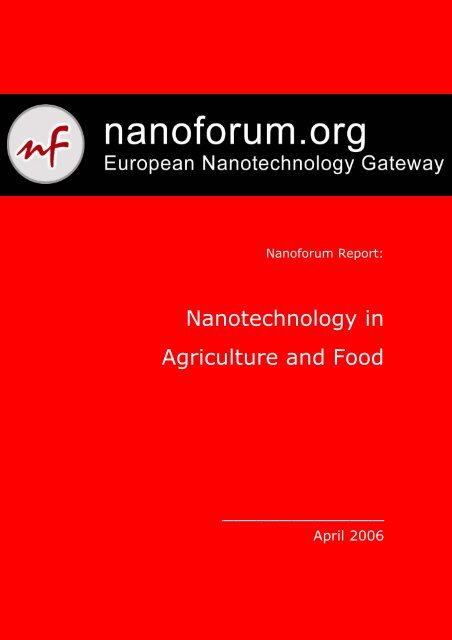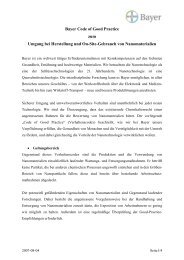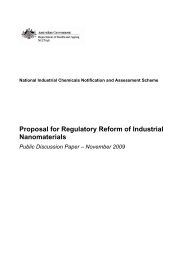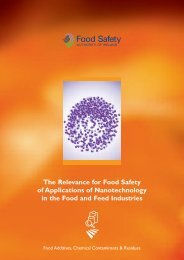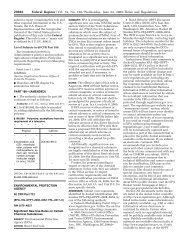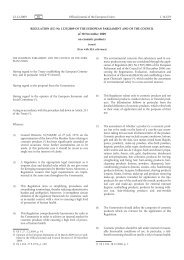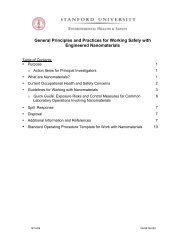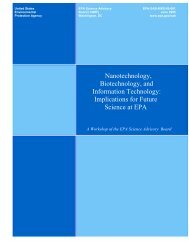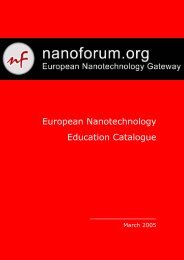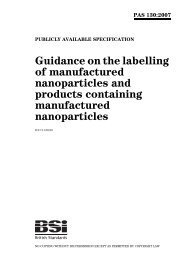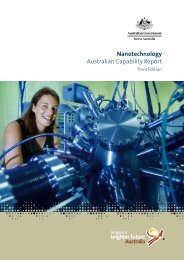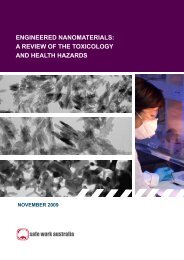Nanotechnology in Agriculture and Food - Europa
Nanotechnology in Agriculture and Food - Europa
Nanotechnology in Agriculture and Food - Europa
You also want an ePaper? Increase the reach of your titles
YUMPU automatically turns print PDFs into web optimized ePapers that Google loves.
Nanoforum Report:<br />
<strong>Nanotechnology</strong> <strong>in</strong><br />
<strong>Agriculture</strong> <strong>and</strong> <strong>Food</strong><br />
______________<br />
April 2006
<strong>Nanotechnology</strong> <strong>in</strong> <strong>Agriculture</strong> <strong>and</strong> <strong>Food</strong><br />
A Nanoforum report, available for download from www.nanoforum.org<br />
Tiju Joseph <strong>and</strong> Mark Morrison<br />
Institute of <strong>Nanotechnology</strong><br />
April 2006<br />
1. Introduction ............................................................................................................................................2<br />
1.1 What is <strong>Nanotechnology</strong>?.....................................................................................................................2<br />
1.2 <strong>Nanotechnology</strong> <strong>in</strong> the <strong>Food</strong> Market ......................................................................................................2<br />
2. <strong>Nanotechnology</strong> <strong>in</strong> <strong>Agriculture</strong> ...................................................................................................................4<br />
2.1 Precision Farm<strong>in</strong>g ...............................................................................................................................4<br />
2.2 Smart Delivery Systems ......................................................................................................................5<br />
2.3 Other Developments <strong>in</strong> the Agricultural Sector due to <strong>Nanotechnology</strong> ......................................................6<br />
3. <strong>Nanotechnology</strong> <strong>in</strong> the <strong>Food</strong> Industry .........................................................................................................7<br />
3.1 Packag<strong>in</strong>g <strong>and</strong> <strong>Food</strong> Safety ..................................................................................................................7<br />
3.2 <strong>Food</strong> Process<strong>in</strong>g ...............................................................................................................................10<br />
4. Conclusions...........................................................................................................................................12<br />
About Nanoforum ......................................................................................................................................13
1. Introduction<br />
The current global population is nearly 6 billion with 50% liv<strong>in</strong>g <strong>in</strong> Asia. A large proportion<br />
of those liv<strong>in</strong>g <strong>in</strong> develop<strong>in</strong>g countries face daily food shortages as a result of environmental<br />
impacts or political <strong>in</strong>stability, while <strong>in</strong> the developed world there is a food surplus. For<br />
develop<strong>in</strong>g countries the drive is to develop drought <strong>and</strong> pest resistant crops, which also<br />
maximize yield. In developed countries, the food <strong>in</strong>dustry is driven by consumer dem<strong>and</strong><br />
which is currently for fresher <strong>and</strong> healthier foodstuffs. This is big bus<strong>in</strong>ess, for example the<br />
food <strong>in</strong>dustry <strong>in</strong> the UK is boom<strong>in</strong>g with an annual growth rate of 5.2% 1 <strong>and</strong> the dem<strong>and</strong> for<br />
fresh food has <strong>in</strong>creased by 10% <strong>in</strong> the last few years.<br />
The potential of nanotechnology to revolutionise the health care, textile, materials.<br />
<strong>in</strong>formation <strong>and</strong> communication technology, <strong>and</strong> energy sectors has been well-publicised. In<br />
fact several products enabled by nanotechnology are already <strong>in</strong> the market, such as antibacterial<br />
dress<strong>in</strong>gs, transparent sunscreen lotions, sta<strong>in</strong>-resistant fabrics, scratch free pa<strong>in</strong>ts<br />
for cars, <strong>and</strong> self clean<strong>in</strong>g w<strong>in</strong>dows. The application of nanotechnology to the agricultural<br />
<strong>and</strong> food <strong>in</strong>dustries was first addressed by a United States Department of <strong>Agriculture</strong><br />
roadmap published <strong>in</strong> September 2003. 2 The prediction is that nanotechnology will<br />
transform the entire food <strong>in</strong>dustry, chang<strong>in</strong>g the way food is produced, processed, packaged,<br />
transported, <strong>and</strong> consumed. This short report will review the key aspects of these<br />
transformations, highlight<strong>in</strong>g current research <strong>in</strong> the agrifood <strong>in</strong>dustry <strong>and</strong> what future<br />
impacts these may have.<br />
1.1 What is <strong>Nanotechnology</strong>?<br />
<strong>Nanotechnology</strong> is the manipulation or self-assembly of <strong>in</strong>dividual atoms, molecules, or<br />
molecular clusters <strong>in</strong>to structures to create materials <strong>and</strong> devices with new or vastly<br />
different properties. <strong>Nanotechnology</strong> can work from the top down (which means reduc<strong>in</strong>g<br />
the size of the smallest structures to the nanoscale e.g. photonics applications <strong>in</strong><br />
nanoelectronics <strong>and</strong> nanoeng<strong>in</strong>eer<strong>in</strong>g) or the bottom up (which <strong>in</strong>volves manipulat<strong>in</strong>g<br />
<strong>in</strong>dividual atoms <strong>and</strong> molecules <strong>in</strong>to nanostructures <strong>and</strong> more closely resembles chemistry or<br />
biology).<br />
The def<strong>in</strong>ition of nanotechnology is based on the prefix “nano” which is from the Greek word<br />
mean<strong>in</strong>g “dwarf”. In more technical terms, the word “nano” means 10 -9 , or one billionth of<br />
someth<strong>in</strong>g. For comparison, a virus is roughly 100 nanometres (nm) <strong>in</strong> size. The word<br />
nanotechnology is generally used when referr<strong>in</strong>g to materials with the size of 0.1 to 100<br />
nanometres, however it is also <strong>in</strong>herent that these materials should display different<br />
properties from bulk (or micrometric <strong>and</strong> larger) materials as a result of their size. These<br />
differences <strong>in</strong>clude physical strength, chemical reactivity, electrical conductance, magnetism,<br />
<strong>and</strong> optical effects.<br />
1.2 <strong>Nanotechnology</strong> <strong>in</strong> the <strong>Food</strong> Market<br />
<strong>Nanotechnology</strong> has been described as the new <strong>in</strong>dustrial revolution <strong>and</strong> both developed <strong>and</strong><br />
develop<strong>in</strong>g countries are <strong>in</strong>vest<strong>in</strong>g <strong>in</strong> this technology to secure a market share. At present<br />
the USA leads with a 4 year, 3.7 billion USD <strong>in</strong>vestment through its National <strong>Nanotechnology</strong><br />
Initiative (NNI). The USA is followed by Japan <strong>and</strong> the European Union, which have both<br />
committed substantial funds (750 million <strong>and</strong> 1.2 billion, <strong>in</strong>clud<strong>in</strong>g <strong>in</strong>dividual country<br />
contributions, respectively per year). 3 The level of fund<strong>in</strong>g <strong>in</strong> develop<strong>in</strong>g countries may be<br />
comparatively lower, however this has not lessened the impact of some countries on the<br />
global stage. For example, Ch<strong>in</strong>a's share of academic publications <strong>in</strong> nanoscale science <strong>and</strong><br />
eng<strong>in</strong>eer<strong>in</strong>g topics rose from 7.5% <strong>in</strong> 1995 to 18.3% <strong>in</strong> 2004, tak<strong>in</strong>g the country from fifth<br />
to second <strong>in</strong> the world. 4 Others such as India, South Korea, Iran, <strong>and</strong> Thail<strong>and</strong> are also<br />
1 Taylor Nelson Sofrès, 52 weeks ended 5 January 2003, Geest estimates<br />
2 Nanoscale science <strong>and</strong> eng<strong>in</strong>eer<strong>in</strong>g for agriculture <strong>and</strong> food systems, Dept. of <strong>Agriculture</strong>, United States, 2003.<br />
3 Some Figures about <strong>Nanotechnology</strong> R&D <strong>in</strong> Europe <strong>and</strong> Beyond, European Commission, December 2005<br />
4 Rank<strong>in</strong>g the Nations: Nanotech's Shift<strong>in</strong>g Global Leaders, Lux Research Inc.<br />
2
catch<strong>in</strong>g up with a focus on applications specific to the economic growth <strong>and</strong> needs of their<br />
countries. Iran for example has a focused programme <strong>in</strong> nanotechnology for the agricultural<br />
<strong>and</strong> food <strong>in</strong>dustry. A recent study from the Helmuth Kaiser Consultancy predicts that the<br />
nanofood market will surge from 2.6 billion USD to 20.4 billion USD by 2010 (see Figure<br />
below). 5 The report suggests that with more than 50% of the world population, the largest<br />
market for Nanofood <strong>in</strong> 2010 will be Asia lead by Ch<strong>in</strong>a.<br />
Nanofood Market<br />
25<br />
20<br />
20.4<br />
$ Billions<br />
15<br />
10<br />
5<br />
2.6<br />
7<br />
0<br />
2004 2006 2010<br />
Year (Helmut Kaiser Consultancy-2004)<br />
World Nanofood market<br />
More than 400 companies around the world today are active <strong>in</strong> nanotechnology research <strong>and</strong><br />
development (R&D) <strong>and</strong> this number is expected to <strong>in</strong>crease to more than 1000 with<strong>in</strong> the<br />
next 10 years. In terms of numbers, the USA leads, followed by Japan, Ch<strong>in</strong>a, <strong>and</strong> the EU.<br />
An estimate by the Bus<strong>in</strong>ess Communications Company, a technical market research <strong>and</strong><br />
<strong>in</strong>dustry analysis company shows that, the market for the nanotechnology was 7.6 billion<br />
USD <strong>in</strong> 2003 <strong>and</strong> is expected to be 1 trillion USD <strong>in</strong> 2011. 6 However, the full potential of<br />
nanotechnology <strong>in</strong> the agricultural <strong>and</strong> food <strong>in</strong>dustry has still not been realised.<br />
5 Helmuth Kaiser Consultancy, <strong>Nanotechnology</strong> <strong>in</strong> <strong>Food</strong> <strong>and</strong> <strong>Food</strong> Process<strong>in</strong>g Industry Worldwide, 2004<br />
6 Bus<strong>in</strong>ess Communications Company, Inc., Global <strong>Nanotechnology</strong> market to reach $29billion by 2008<br />
3
2. <strong>Nanotechnology</strong> <strong>in</strong> <strong>Agriculture</strong><br />
The EU’s vision is of a “knowledge-based economy” <strong>and</strong> as part of this, it plans to maximise<br />
the potential of biotechnology for the benefit of EU economy, society <strong>and</strong> the environment.<br />
There are new challenges <strong>in</strong> this sector <strong>in</strong>clud<strong>in</strong>g a grow<strong>in</strong>g dem<strong>and</strong> for healthy, safe food;<br />
an <strong>in</strong>creas<strong>in</strong>g risk of disease; <strong>and</strong> threats to agricultural <strong>and</strong> fishery production from<br />
chang<strong>in</strong>g weather patterns. However, creat<strong>in</strong>g a bio economy is a challeng<strong>in</strong>g <strong>and</strong> complex<br />
process <strong>in</strong>volv<strong>in</strong>g the convergence of different branches of science.<br />
<strong>Nanotechnology</strong> has the potential to revolutionize the agricultural <strong>and</strong> food <strong>in</strong>dustry with<br />
new tools for the molecular treatment of diseases, rapid disease detection, enhanc<strong>in</strong>g the<br />
ability of plants to absorb nutrients etc. Smart sensors <strong>and</strong> smart delivery systems will help<br />
the agricultural <strong>in</strong>dustry combat viruses <strong>and</strong> other crop pathogens. In the near future<br />
nanostructured catalysts will be available which will <strong>in</strong>crease the efficiency of pesticides <strong>and</strong><br />
herbicides, allow<strong>in</strong>g lower doses to be used. <strong>Nanotechnology</strong> will also protect the<br />
environment <strong>in</strong>directly through the use of alternative (renewable) energy supplies, <strong>and</strong><br />
filters or catalysts to reduce pollution <strong>and</strong> clean-up exist<strong>in</strong>g pollutants.<br />
An agricultural methodology widely used <strong>in</strong> the USA, Europe <strong>and</strong> Japan, which efficiently<br />
utilises modern technology for crop management, is called Controlled Environment<br />
<strong>Agriculture</strong> (CEA). CEA is an advanced <strong>and</strong> <strong>in</strong>tensive form of hydroponically-based<br />
agriculture. Plants are grown with<strong>in</strong> a controlled environment so that horticultural practices<br />
can be optimized. The computerized system monitors <strong>and</strong> regulates localised environments<br />
such as fields of crops. CEA technology, as it exists today, provides an excellent platform for<br />
the <strong>in</strong>troduction of nanotechnology to agriculture. With many of the monitor<strong>in</strong>g <strong>and</strong> control<br />
systems already <strong>in</strong> place, nanotechnological devices for CEA that provide “scout<strong>in</strong>g”<br />
capabilities could tremendously improve the grower’s ability to determ<strong>in</strong>e the best time of<br />
harvest for the crop, the vitality of the crop, <strong>and</strong> food security issues, such as microbial or<br />
chemical contam<strong>in</strong>ation. 7<br />
2.1 Precision Farm<strong>in</strong>g<br />
Precision farm<strong>in</strong>g has been a long-desired goal to maximise output (i.e. crop yields) while<br />
m<strong>in</strong>imis<strong>in</strong>g <strong>in</strong>put (i.e. fertilisers, pesticides, herbicides, etc) through monitor<strong>in</strong>g<br />
environmental variables <strong>and</strong> apply<strong>in</strong>g targeted action. Precision farm<strong>in</strong>g makes use of<br />
computers, global satellite position<strong>in</strong>g systems, <strong>and</strong> remote sens<strong>in</strong>g devices to measure<br />
highly localised environmental conditions thus determ<strong>in</strong><strong>in</strong>g whether crops are grow<strong>in</strong>g at<br />
maximum efficiency or precisely identify<strong>in</strong>g the nature <strong>and</strong> location of problems. By us<strong>in</strong>g<br />
centralised data to determ<strong>in</strong>e soil conditions <strong>and</strong> plant development, seed<strong>in</strong>g, fertilizer,<br />
chemical <strong>and</strong> water use can be f<strong>in</strong>e-tuned to lower production costs <strong>and</strong> potentially <strong>in</strong>crease<br />
production- all benefit<strong>in</strong>g the farmer. 8 Precision farm<strong>in</strong>g can also help to reduce agricultural<br />
waste <strong>and</strong> thus keep environmental pollution to a m<strong>in</strong>imum. Although not fully implemented<br />
yet, t<strong>in</strong>y sensors <strong>and</strong> monitor<strong>in</strong>g systems enabled by nanotechnology will have a large<br />
impact on future precision farm<strong>in</strong>g methodologies.<br />
One of the major roles for nanotechnology-enabled devices will be the <strong>in</strong>creased use of<br />
autonomous sensors l<strong>in</strong>ked <strong>in</strong>to a GPS system for real-time monitor<strong>in</strong>g. These nanosensors<br />
could be distributed throughout the field where they can monitor soil conditions <strong>and</strong> crop<br />
growth. Wireless sensors are already be<strong>in</strong>g used <strong>in</strong> certa<strong>in</strong> parts of the USA <strong>and</strong> Australia.<br />
For example, one of the Californian v<strong>in</strong>eyards, Pickberry, <strong>in</strong> Sonoma County has <strong>in</strong>stalled wifi<br />
systems with the help of the IT company, Accenture. 9 The <strong>in</strong>itial cost of sett<strong>in</strong>g up such a<br />
system is justified by the fact that it enables the best grapes to be grown which <strong>in</strong> turn<br />
produce f<strong>in</strong>er w<strong>in</strong>es, which comm<strong>and</strong> a premium price. The use of such wireless networks is<br />
of course not restricted to v<strong>in</strong>eyards, for example Forbes Magaz<strong>in</strong>e has reported that small<br />
7 The US Department of <strong>Agriculture</strong>, Nanoscale science <strong>and</strong> eng<strong>in</strong>eer<strong>in</strong>g for <strong>Agriculture</strong> <strong>and</strong> food systems<br />
8 Precision <strong>Agriculture</strong>: Chang<strong>in</strong>g the Face of Farm<strong>in</strong>g, Doug Rickman, J.C. Luvall, Joey Shaw, Paul Mask, David<br />
Kissel <strong>and</strong> Dana Sullivan<br />
9 Virtual V<strong>in</strong>eyard, Gregory J. Millman, Accenture,<br />
http://www.accenture.com/xdoc/en/ideas/outlook/3_2004/pdf/case_sensor.pdf<br />
4
nanosensors are be<strong>in</strong>g used by Honeywell (a technology R&D company with global branches)<br />
to monitor grocery stores <strong>in</strong> M<strong>in</strong>nesota. 10 This technology enables shop keepers to identify<br />
food items which have passed their expiry date <strong>and</strong> also rem<strong>in</strong>ds them to issue a new<br />
purchase order. The global market for wireless sensors is predicted to be 7 billion USD by<br />
2010. 11<br />
The union of biotechnology <strong>and</strong> nanotechnology <strong>in</strong> sensors will create equipment of<br />
<strong>in</strong>creased sensitivity, allow<strong>in</strong>g an earlier response to environmental changes. For example:<br />
• Nanosensors utilis<strong>in</strong>g carbon nanotubes 12 or nano-cantilevers 13 are small enough to trap<br />
<strong>and</strong> measure <strong>in</strong>dividual prote<strong>in</strong>s or even small molecules.<br />
• Nanoparticles or nanosurfaces can be eng<strong>in</strong>eered to trigger an electrical or chemical<br />
signal <strong>in</strong> the presence of a contam<strong>in</strong>ant such as bacteria.<br />
• Other nanosensors work by trigger<strong>in</strong>g an enzymatic reaction or by us<strong>in</strong>g nanoeng<strong>in</strong>eered<br />
branch<strong>in</strong>g molecules called dendrimers as probes to b<strong>in</strong>d to target chemicals<br />
<strong>and</strong> prote<strong>in</strong>s. 14<br />
Ultimately, precision farm<strong>in</strong>g, with the help of smart sensors, will allow enhanced<br />
productivity <strong>in</strong> agriculture by provid<strong>in</strong>g accurate <strong>in</strong>formation, thus help<strong>in</strong>g farmers to make<br />
better decisions.<br />
2.2 Smart Delivery Systems<br />
The use of pesticides <strong>in</strong>creased <strong>in</strong> the second half of the 20 th century with DDT becom<strong>in</strong>g<br />
one of the most effective <strong>and</strong> widespread throughout the world. However, many of these<br />
pesticides, <strong>in</strong>clud<strong>in</strong>g DDT were later found to be highly toxic, affect<strong>in</strong>g human <strong>and</strong> animal<br />
health <strong>and</strong> as a result whole ecosystems. As a consequence they were banned. To ma<strong>in</strong>ta<strong>in</strong><br />
crop yields, Integrated Pest Management systems, which mix traditional methods of crop<br />
rotation with biological pest control methods, are becom<strong>in</strong>g popular <strong>and</strong> implemented <strong>in</strong><br />
many countries, such as Tunisia <strong>and</strong> India.<br />
In the future, nanoscale devices with novel properties could be used to make agricultural<br />
systems “smart”. For example, devices could be used to identify plant health issues before<br />
these become visible to the farmer. Such devices may be capable of respond<strong>in</strong>g to different<br />
situations by tak<strong>in</strong>g appropriate remedial action. If not, they will alert the farmer to the<br />
problem. In this way, smart devices will act as both a preventive <strong>and</strong> an early warn<strong>in</strong>g<br />
system. Such devices could be used to deliver chemicals <strong>in</strong> a controlled <strong>and</strong> targeted<br />
manner <strong>in</strong> the same way as nanomedic<strong>in</strong>e has implications for drug delivery <strong>in</strong> humans.<br />
Nanomedic<strong>in</strong>e developments are now beg<strong>in</strong>n<strong>in</strong>g to allow us to treat different diseases such<br />
as cancer <strong>in</strong> animals with high precision, <strong>and</strong> targeted delivery (to specific tissues <strong>and</strong><br />
organs) has become highly successful.<br />
Technologies such as encapsulation <strong>and</strong> controlled release methods, have revolutionised the<br />
use of pesticides <strong>and</strong> herbicides. Many companies make formulations which conta<strong>in</strong><br />
nanoparticles with<strong>in</strong> the 100-250 nm size range that are able to dissolve <strong>in</strong> water more<br />
effectively than exist<strong>in</strong>g ones (thus <strong>in</strong>creas<strong>in</strong>g their activity). Other companies employ<br />
suspensions of nanoscale particles (nanoemulsions), which can be either water or oil-based<br />
<strong>and</strong> conta<strong>in</strong> uniform suspensions of pesticidal or herbicidal nanoparticles <strong>in</strong> the range of 200-<br />
400 nm. These can be easily <strong>in</strong>corporated <strong>in</strong> various media such as gels, creams, liquids<br />
etc, <strong>and</strong> have multiple applications for preventative measures, treatment or preservation of<br />
the harvested product.<br />
One of the world’s largest agrochemical corporations, Syngenta, is us<strong>in</strong>g nanoemulsions <strong>in</strong><br />
its pesticide products. One of its successful growth regulat<strong>in</strong>g products is the Primo MAXX ®<br />
plant growth regulator, which if applied prior to the onset of stress such as heat, drought,<br />
10 Quent<strong>in</strong> Hardy, Sens<strong>in</strong>g opportunity, Forbes Magaz<strong>in</strong>e, 2003<br />
11 ONWorld Press Release, Wireless sensor networks: A mass market opportunity<br />
12 Carbon nanotubes are rolled sheets of graphite that are hollow <strong>and</strong> a few nm <strong>in</strong> diameter, but can be several<br />
micrometres (or more) long.<br />
13 Cantilevers are micro-scaled structures that can be modified to b<strong>in</strong>d specific chemicals. B<strong>in</strong>d<strong>in</strong>g causes the<br />
cantilever to bend (much like a div<strong>in</strong>g board), <strong>and</strong> this movement is detected optically or electronically.<br />
14 Down on the farm, ETC group, 2004: http://www.etcgroup.org/documents/ETC_DOTFarm2004.pdf<br />
5
disease or traffic can strengthen the physical structure of turfgrass, <strong>and</strong> allow it to withst<strong>and</strong><br />
ongo<strong>in</strong>g stresses throughout the grow<strong>in</strong>g season. 15 Another encapsulated product from<br />
Syngenta delivers a broad control spectrum on primary <strong>and</strong> secondary <strong>in</strong>sect pests of cotton,<br />
rice, peanuts <strong>and</strong> soybeans. Marketed under the name Karate ® ZEON this is a quick release<br />
microencapsulated product conta<strong>in</strong><strong>in</strong>g the active compound lambda-cyhalothr<strong>in</strong> (a synthetic<br />
<strong>in</strong>secticide based on the structure of natural pyrethr<strong>in</strong>s) which breaks open on contact with<br />
leaves. 16 In contrast, the encapsulated product “gutbuster” only breaks open to release its<br />
contents when it comes <strong>in</strong>to contact with alkal<strong>in</strong>e environments, such as the stomach of<br />
certa<strong>in</strong> <strong>in</strong>sects. 17<br />
In other areas, scientists are work<strong>in</strong>g on various technologies to make fertiliser <strong>and</strong> pesticide<br />
delivery systems which can respond to environmental changes. The ultimate aim is to tailor<br />
these products <strong>in</strong> such a way that they will release their cargo <strong>in</strong> a controlled manner (slowly<br />
or quickly) <strong>in</strong> response to different signals e.g. magnetic fields, heat, ultrasound, moisture,<br />
etc.<br />
New research also aims to make plants use water, pesticides <strong>and</strong> fertilizers more efficiently,<br />
to reduce pollution <strong>and</strong> to make agriculture more environmentally friendly. Smaller<br />
companies are form<strong>in</strong>g alliances with major players such as LG, BASF, Honeywell, Bayer,<br />
Mitsubishi, <strong>and</strong> DuPont to make complete plant health monitor<strong>in</strong>g systems <strong>in</strong> the next 10<br />
years us<strong>in</strong>g nanotechnologies.<br />
2.3 Other Developments <strong>in</strong> the Agricultural Sector due to<br />
<strong>Nanotechnology</strong><br />
<strong>Agriculture</strong> is the backbone of most develop<strong>in</strong>g countries, with more than 60% of the<br />
population reliant on it for their livelihood. As well as develop<strong>in</strong>g improved systems for<br />
monitor<strong>in</strong>g environmental conditions <strong>and</strong> deliver<strong>in</strong>g nutrients or pesticides as appropriate,<br />
nanotechnology can improve our underst<strong>and</strong><strong>in</strong>g of the biology of different crops <strong>and</strong> thus<br />
potentially enhance yields or nutritional values. In addition, it can offer routes to added<br />
value crops or environmental remediation.<br />
Particle farm<strong>in</strong>g is one such example, which yields nanoparticles for <strong>in</strong>dustrial use by<br />
grow<strong>in</strong>g plants <strong>in</strong> def<strong>in</strong>ed soils. For example, research has shown that alfalfa plants grown<br />
<strong>in</strong> gold rich soil, absorb gold nanoparticles through their roots <strong>and</strong> accumulate these <strong>in</strong> their<br />
tissues. The gold nanoparticles can be mechanically separated from the plant tissue<br />
follow<strong>in</strong>g harvest. 18<br />
<strong>Nanotechnology</strong> can also be used to clean ground water. The US company Argonide is us<strong>in</strong>g<br />
2 nm diameter alum<strong>in</strong>ium oxide nanofibres (NanoCeram) as a water purifier. Filters made<br />
from these fibres can remove viruses, bacteria <strong>and</strong> protozoan cysts from water. 19 Similar<br />
projects are tak<strong>in</strong>g place elsewhere, particularly <strong>in</strong> develop<strong>in</strong>g countries such as India <strong>and</strong><br />
South Africa. The German chemical group BASF’s future bus<strong>in</strong>ess fund has devoted a<br />
significant proportion of its 105 million USD nanotechnology research fund to water<br />
purification techniques. The French utility company Generale des Eaux has also developed<br />
its own Nanofiltration technology <strong>in</strong> collaboration with the Dow Chemical subsidiary Filmtec.<br />
Ondeo, the water unit of French conglomerate Suez, has meanwhile <strong>in</strong>stalled what it calls an<br />
ultrafiltration system, with holes of 0.1 microns <strong>in</strong> size, <strong>in</strong> one of its plants outside Paris. 20<br />
While some companies are work<strong>in</strong>g on water filtration, others such as Altairnano are<br />
follow<strong>in</strong>g a purification approach. Altairnano’s Nanocheck conta<strong>in</strong>s lanthanum nanoparticles<br />
that absorb phosphates from aqueous environments. Apply<strong>in</strong>g these <strong>in</strong> ponds <strong>and</strong><br />
swimm<strong>in</strong>g pools effectively removes available phosphates <strong>and</strong> as a result prevents the<br />
15 http://www.syngentaprofessionalproducts.com/to/prod/primo/<br />
16 http://www.syngentacropprotection-us.com/prod/<strong>in</strong>secticide/Karate/<br />
17 Syngenta’s US Patent No. 6,544,540: Base-Triggered Release Microcapsules<br />
18<br />
Liz Kalaugher, Alfalfa plants harvest gold Nanoparticles, Nanotechweb<br />
19 http://nanotechweb.org/articles/news/3/4/7<br />
20 Small times, http://www.smalltimes.com/document_display.cfm?document_id=6959<br />
6
growth of algae. The company expects this product to benefit commercial fish ponds which<br />
spend huge amounts of money to remove algae. 21<br />
Research at Lehigh University <strong>in</strong> the US shows that an ultraf<strong>in</strong>e, nanoscale powder made<br />
from iron can be used as an effective tool for clean<strong>in</strong>g up contam<strong>in</strong>ated soil <strong>and</strong><br />
groundwater- a trillion-dollar problem that encompasses more than 1000 still-untreated<br />
Superfund sites (uncontrolled or ab<strong>and</strong>oned places where hazardous waste is located) <strong>in</strong> the<br />
United States, some 150,000 underground storage tank releases, <strong>and</strong> a huge number of<br />
l<strong>and</strong>fills, ab<strong>and</strong>oned m<strong>in</strong>es, <strong>and</strong> <strong>in</strong>dustrial sites. 22 The iron nanoparticles catalyse the<br />
oxidation <strong>and</strong> breakdown of organic contam<strong>in</strong>ants such as trichloroethene, carbon<br />
tetrachloride, diox<strong>in</strong>s, <strong>and</strong> PCBs to simpler carbon compounds which are much less toxic.<br />
This could pave the way for a nano-aquaculture, which would be beneficial for a large<br />
number of farmers across the world. Other research at the Centre for Biological <strong>and</strong><br />
Environmental <strong>Nanotechnology</strong> (CBEN) has shown that nanoscale iron oxide particles are<br />
extremely effective at b<strong>in</strong>d<strong>in</strong>g <strong>and</strong> remov<strong>in</strong>g arsenic from groundwater (someth<strong>in</strong>g which<br />
affects the water supply of millions of people <strong>in</strong> the develop<strong>in</strong>g world, <strong>and</strong> for which there is<br />
no effective exist<strong>in</strong>g solution). 23<br />
3. <strong>Nanotechnology</strong> <strong>in</strong> the <strong>Food</strong> Industry<br />
The impact of nanotechnology <strong>in</strong> the food <strong>in</strong>dustry has become more apparent over the last<br />
few years with the organization of various conferences dedicated to the topic, <strong>in</strong>itiation of<br />
consortia for better <strong>and</strong> safe food, along with <strong>in</strong>creased coverage <strong>in</strong> the media. Several<br />
companies which were hesitant about reveal<strong>in</strong>g their research programmes <strong>in</strong> nanofood,<br />
have now gone public announc<strong>in</strong>g plans to improve exist<strong>in</strong>g products <strong>and</strong> develop new ones<br />
to ma<strong>in</strong>ta<strong>in</strong> market dom<strong>in</strong>ance. The types of application <strong>in</strong>clude: smart packag<strong>in</strong>g, on<br />
dem<strong>and</strong> preservatives, <strong>and</strong> <strong>in</strong>teractive foods. Build<strong>in</strong>g on the concept of “on-dem<strong>and</strong>” food,<br />
the idea of <strong>in</strong>teractive food is to allow consumers to modify food depend<strong>in</strong>g on their own<br />
nutritional needs or tastes. The concept is that thous<strong>and</strong>s of nanocapsules conta<strong>in</strong><strong>in</strong>g<br />
flavour or colour enhancers, or added nutritional elements (such as vitam<strong>in</strong>s), would rema<strong>in</strong><br />
dormant <strong>in</strong> the food <strong>and</strong> only be released when triggered by the consumer. 24 Most of the<br />
food giants <strong>in</strong>clud<strong>in</strong>g Nestle, Kraft, He<strong>in</strong>z, <strong>and</strong> Unilever support specific research<br />
programmes to capture a share of the nanofood market <strong>in</strong> the next decade.<br />
The def<strong>in</strong>ition of nanofood is that nanotechnology techniques or tools are used dur<strong>in</strong>g<br />
cultivation, production, process<strong>in</strong>g, or packag<strong>in</strong>g of the food. It does not mean atomically<br />
modified food or food produced by nanomach<strong>in</strong>es. Although there are ambitious thoughts of<br />
creat<strong>in</strong>g molecular food us<strong>in</strong>g nanomach<strong>in</strong>es, this is unrealistic <strong>in</strong> the foreseeable future.<br />
Instead nanotechnologists are more optimistic about the potential to change the exist<strong>in</strong>g<br />
system of food process<strong>in</strong>g <strong>and</strong> to ensure the safety of food products, creat<strong>in</strong>g a healthy food<br />
culture. They are also hopeful of enhanc<strong>in</strong>g the nutritional quality of food through selected<br />
additives <strong>and</strong> improvements to the way the body digests <strong>and</strong> absorbs food. Although some<br />
of these goals are further away, the food packag<strong>in</strong>g <strong>in</strong>dustry already <strong>in</strong>corporates<br />
nanotechnology <strong>in</strong> products.<br />
3.1 Packag<strong>in</strong>g <strong>and</strong> <strong>Food</strong> Safety<br />
Develop<strong>in</strong>g smart packag<strong>in</strong>g to optimise product shelf-life has been the goal of many<br />
companies. Such packag<strong>in</strong>g systems would be able to repair small holes/tears, respond to<br />
environmental conditions (e.g. temperature <strong>and</strong> moisture changes), <strong>and</strong> alert the customer<br />
if the food is contam<strong>in</strong>ated. <strong>Nanotechnology</strong> can provide solutions for these, for example<br />
modify<strong>in</strong>g the permeation behaviour of foils, <strong>in</strong>creas<strong>in</strong>g barrier properties (mechanical,<br />
thermal, chemical, <strong>and</strong> microbial), improv<strong>in</strong>g mechanical <strong>and</strong> heat-resistance properties,<br />
21 Altairnano, http://www.altairnano.com/applications.html<br />
22 NanoApex, http://news.nanoapex.com/modules.php?name=News&file=article&sid=3790<br />
23 http://cohesion.rice.edu/centers<strong>and</strong><strong>in</strong>st/cben/research.cfm?doc_id=5100<br />
24 John Dunn, “A M<strong>in</strong>i Revolution,” <strong>Food</strong> Manufacture, September 1, 2004.<br />
http://www.foodmanufacture.co.uk/news/fullstory.php/aid/472/A_m<strong>in</strong>i_revolution.html<br />
7
develop<strong>in</strong>g active antimicrobic <strong>and</strong> antifungal surfaces, <strong>and</strong> sens<strong>in</strong>g as well as signall<strong>in</strong>g<br />
microbiological <strong>and</strong> biochemical changes. 25<br />
The f<strong>in</strong>ancial outlook for nanotechnology enabled packag<strong>in</strong>g looks buoyant. The current<br />
packag<strong>in</strong>g market st<strong>and</strong>s at 1.1 billion USD <strong>and</strong> is predicted to <strong>in</strong>crease to 3.7 billion USD by<br />
2010. With<strong>in</strong> this, the Smart Packag<strong>in</strong>g <strong>in</strong>dustry is grow<strong>in</strong>g faster than predicted <strong>and</strong> is<br />
already show<strong>in</strong>g signs of maturity. Research by the f<strong>in</strong>ancial firm Frost <strong>and</strong> Sullivan, found<br />
that today’s consumers dem<strong>and</strong> much more from packag<strong>in</strong>g <strong>in</strong> terms of protect<strong>in</strong>g the<br />
quality, freshness <strong>and</strong> safety of foods, as well as convenience. They conclude that this is<br />
one of the ma<strong>in</strong> reasons beh<strong>in</strong>d the <strong>in</strong>creased <strong>in</strong>terest <strong>in</strong> <strong>in</strong>novative methods of packag<strong>in</strong>g. 26<br />
There are several organizations develop<strong>in</strong>g Smart Packag<strong>in</strong>g systems. For example, Kraft<br />
foods, along with researchers at Rutgers University <strong>in</strong> the US, is develop<strong>in</strong>g an “electronic<br />
tongue” for <strong>in</strong>clusion <strong>in</strong> packag<strong>in</strong>g. This consists of an array of nanosensors which are<br />
extremely sensitive to gases released by food as it spoils, caus<strong>in</strong>g the sensor strip to change<br />
colour as a result, giv<strong>in</strong>g a clear visible signal of whether the food is fresh or not.<br />
Bayer Polymers has developed the Durethan KU2-2601 packag<strong>in</strong>g film, which is lighter,<br />
stronger <strong>and</strong> more heat resistant than those currently on the market. The primary purpose<br />
of food packag<strong>in</strong>g films is to prevent contents from dry<strong>in</strong>g out <strong>and</strong> to protect them from<br />
moisture <strong>and</strong> oxygen. The new film is known as a “hybrid system” that is enriched with an<br />
enormous number of silicate nanoparticles. These massively reduce the entrance of oxygen<br />
<strong>and</strong> other gases, <strong>and</strong> the exit of moisture, thus prevent<strong>in</strong>g food from spoil<strong>in</strong>g. 27<br />
Breweries would ideally use plastic bottles to ship beer, as these are lighter than glass <strong>and</strong><br />
cheaper than metal cans. However, alcohol <strong>in</strong> beer reacts with the plastic used for the<br />
bottles, severely shorten<strong>in</strong>g shelf-life. Voridan, <strong>in</strong> association with Nanocor, has developed a<br />
nanocomposite conta<strong>in</strong><strong>in</strong>g clay nanoparticles, called Imperm. The resultant bottle is both<br />
lighter <strong>and</strong> stronger than glass <strong>and</strong> is less likely to shatter. The nanocomposite structure<br />
m<strong>in</strong>imises loss of carbon dioxide from the beer <strong>and</strong> the <strong>in</strong>gress of oxygen to the bottle,<br />
keep<strong>in</strong>g the beer fresher <strong>and</strong> giv<strong>in</strong>g it up to a six-month shelf life. 28 The technology has<br />
been adopted by several companies <strong>in</strong>clud<strong>in</strong>g the Miller Brew<strong>in</strong>g Co.. Honeywell Specialty<br />
Polymers, has also successfully eng<strong>in</strong>eered plastic beer bottles that <strong>in</strong>corporate<br />
nanocomposites giv<strong>in</strong>g an extended shelf life (up to 26 weeks). The “Aegis” nylon 6 is the<br />
barrier layer <strong>in</strong> this 3-layered construction <strong>and</strong> has been used s<strong>in</strong>ce late 2003 <strong>in</strong> the 1.6-litre<br />
Hite Pitcher beer bottle from Hite Brewery Co. <strong>in</strong> South Korea. 29 In a different strategy,<br />
Kodak is develop<strong>in</strong>g antimicrobial films that have the ability to absorb oxygen from the<br />
contents of the package, thus imped<strong>in</strong>g food deterioration.<br />
Other organizations are look<strong>in</strong>g at ways <strong>in</strong> which nanotechnology can offer improvements <strong>in</strong><br />
sensitivity or ease by which contam<strong>in</strong>ation of food is detected. For example, AgroMicron has<br />
developed the NanoBiolum<strong>in</strong>escence Detection Spray which conta<strong>in</strong>s a lum<strong>in</strong>escent prote<strong>in</strong><br />
that has been eng<strong>in</strong>eered to b<strong>in</strong>d to the surface of microbes such as Salmonella <strong>and</strong> E. coli.<br />
When bound, it emits a visible glow, thus allow<strong>in</strong>g easy detection of contam<strong>in</strong>ated food or<br />
beverages. The more <strong>in</strong>tense the glow is, the higher the bacterial contam<strong>in</strong>ation. The<br />
company aims to market the product under the name BioMark <strong>and</strong> is currently design<strong>in</strong>g<br />
new spray techniques to apply <strong>in</strong> ocean freight conta<strong>in</strong>erized shipp<strong>in</strong>g as well as to fight<br />
bioterrorism. 30<br />
In a similar strategy to ensure food safety, EU researchers <strong>in</strong> the Good <strong>Food</strong> Project have<br />
developed a portable nanosensor to detect chemicals, pathogens <strong>and</strong> tox<strong>in</strong>s <strong>in</strong> food. 31 This<br />
circumvents the need to send samples to laboratories (which is both costly <strong>and</strong> lengthy),<br />
allow<strong>in</strong>g food to be analysed for safety <strong>and</strong> quality at the farm, abattoir, dur<strong>in</strong>g transport,<br />
process<strong>in</strong>g or at the packag<strong>in</strong>g plant. The project is also develop<strong>in</strong>g a device us<strong>in</strong>g DNA<br />
25 <strong>Nanotechnology</strong> targets new food packag<strong>in</strong>g products, www.foodproductiondaily.com<br />
26 http://www.foodproductiondaily.com/news/ng.asp?id=63704<br />
27 Nanoparticles make Durethan® films airtight <strong>and</strong> glossy, Bayer Polymers<br />
28 Safer And Guilt-Free Nano <strong>Food</strong>s, Josh Wolfe, Forbes/Wolfe Nanotech Report, www.forbes.com<br />
29 http://www.ptonl<strong>in</strong>e.com/articles/kuw/12437.html<br />
30 http://www.agromicron.com/BTP.htm<br />
31 http://www.goodfood-project.org/<br />
8
iochips to detect pathogens- a technique that could also be applied to determ<strong>in</strong>e the<br />
presence of different k<strong>in</strong>ds of harmful bacteria <strong>in</strong> meat or fish, or fungi affect<strong>in</strong>g fruit. The<br />
project also has plans to develop microarray sensors that can be used to identify pesticides<br />
on fruit <strong>and</strong> vegetables as well as those which will monitor environmental conditions at the<br />
farm. These have been co<strong>in</strong>ed “Good <strong>Food</strong> sensors”.<br />
The EU-funded BioF<strong>in</strong>ger project, which has the aim of develop<strong>in</strong>g “versatile, <strong>in</strong>expensive,<br />
<strong>and</strong> easy-to-use diagnostic tools for health, environmental <strong>and</strong> other applications”, has<br />
found a different application <strong>in</strong> food analysis. The device uses cantilever technology, <strong>in</strong><br />
which the tip of the cantilever is coated with chemicals allow<strong>in</strong>g it to bend <strong>and</strong> resonate<br />
when it b<strong>in</strong>ds specific molecules (such as those on the surface of bacteria). The BioF<strong>in</strong>ger<br />
device <strong>in</strong>corporates the cantilevers on a disposable microchip mak<strong>in</strong>g it small <strong>and</strong> portable. 32<br />
The US military is develop<strong>in</strong>g super sensors to be used <strong>in</strong> times of terrorist attacks on food<br />
supplies. Current systems can take several days to confirm the presence of pathogens <strong>in</strong><br />
food, however new nanotechnology enabled super sensors will be able to detect pathogens<br />
immediately. Such technology would have widespread applications <strong>in</strong> the food <strong>in</strong>dustry.<br />
Researchers at the University of Bonn are develop<strong>in</strong>g dirt repellent coat<strong>in</strong>gs for packages<br />
us<strong>in</strong>g the lotus effect (water beads <strong>and</strong> runs off the surface of lotus leaves as a result of<br />
nanoscale wax pyramids which coat the leaves). Abattoirs <strong>and</strong> meat process<strong>in</strong>g plants <strong>in</strong><br />
particular could benefit from such technology. A research group at the University of Leeds <strong>in</strong><br />
UK has determ<strong>in</strong>ed that nanoparticles of magnesium oxide <strong>and</strong> z<strong>in</strong>c oxide are highly<br />
effective at destroy<strong>in</strong>g microorganisms. As these would be much cheaper to manufacture<br />
than silver nanoparticles, this could have tremendous applications <strong>in</strong> food packag<strong>in</strong>g. 33<br />
<strong>Nanotechnology</strong> has also found applications <strong>in</strong> monitor<strong>in</strong>g <strong>and</strong> tagg<strong>in</strong>g of food items. Radio<br />
Frequency Identification (RFID) technology was developed by the military more than 50<br />
years ago, but has now found its way to numerous applications from food monitor<strong>in</strong>g <strong>in</strong><br />
shops to improv<strong>in</strong>g supply cha<strong>in</strong> efficiency. The technology, which consists of<br />
microprocessors <strong>and</strong> an antenna that can transmit data to a wireless receiver, can be used<br />
to monitor an item from the warehouse to the consumer’s h<strong>and</strong>s. 34 Unlike bar codes, which<br />
need to be scanned manually <strong>and</strong> read <strong>in</strong>dividually, RFID tags do not require l<strong>in</strong>e-of-sight for<br />
read<strong>in</strong>g <strong>and</strong> it is possible to automatically read hundreds of tags a second. Retail<strong>in</strong>g cha<strong>in</strong>s<br />
like Wal-Mart, Home Depot, Metro group, <strong>and</strong> Tesco, have already tested this technology.<br />
The ma<strong>in</strong> drawback is the <strong>in</strong>creased production costs due to silicon manufactur<strong>in</strong>g. With the<br />
fusion of nanotechnology <strong>and</strong> electronics (nanotronics), these tags should become cheaper,<br />
easier to implement <strong>and</strong> more efficient.<br />
A group of scientists from Northern European food <strong>in</strong>dustries have created a Nanofood<br />
consortium with the aim of foster<strong>in</strong>g the applications of nanotechnology <strong>in</strong> the food <strong>in</strong>dustry<br />
<strong>in</strong> a responsible manner, to strengthen the effort to develop healthy <strong>and</strong> safe foods. The<br />
found<strong>in</strong>g companies <strong>in</strong>clude Arla <strong>Food</strong>s, Danisco A/S, Aarhus United A/S, Danish Crown<br />
amba, Systematic Software Eng<strong>in</strong>eer<strong>in</strong>g A/S, <strong>and</strong> the Interdiscipl<strong>in</strong>ary Nanoscience Centre<br />
(iNANO). With a mission to provide safe food to consumers, the consortium’s priorities are:<br />
to develop sensors which can almost <strong>in</strong>stantly reveal whether a food sample conta<strong>in</strong>s toxic<br />
compounds or bacteria; to develop anti-bacterial surfaces for mach<strong>in</strong>es <strong>in</strong>volved <strong>in</strong> food<br />
production; to develop th<strong>in</strong>ner, stronger <strong>and</strong> cheaper wrapp<strong>in</strong>gs for food; <strong>and</strong> the creation of<br />
food with a healthier nutritional composition. 35<br />
A study by Denmark’s Centre for Advanced <strong>Food</strong> Studies (LMC), an alliance of Danish<br />
<strong>in</strong>stitutions work<strong>in</strong>g <strong>in</strong> food sciences, has structured their priorities for the 7th Framework<br />
programme. 36 The six priority areas are:<br />
• basic underst<strong>and</strong><strong>in</strong>g of food <strong>and</strong> animal feed for <strong>in</strong>telligent <strong>in</strong>novation<br />
• systems biology <strong>in</strong> food research<br />
32 http://www.biof<strong>in</strong>ger.org/<br />
33 http://www.foodproductiondaily.com/news/ng.asp?n=59980-nanotech-discovery-promises<br />
34 Radio ID Tags: Beyond Bar Codes, http://www.wired.com/news/technology/0,1282,52343,00.html<br />
35 New consortium to secure safe <strong>and</strong> healthy food, Press release,14-06-2005, http://www.scanbalt.org/sw4126.asp<br />
36 Danish food researchers list priorities for FP7 <strong>and</strong> underl<strong>in</strong>e relevance of nanoscience, Press release, 01-09-2005,<br />
www.lmc.dk<br />
9
• biological renewal <strong>in</strong> the food sector/biological production<br />
• technology development<br />
• nutrigenomics<br />
• consumer needs-driven <strong>in</strong>novation <strong>and</strong> food communication<br />
They believe that a focus on these areas will create a holistic <strong>and</strong> an <strong>in</strong>terdiscipl<strong>in</strong>ary<br />
approach <strong>in</strong> food research <strong>and</strong> development <strong>in</strong> Europe. They are aim<strong>in</strong>g to produce<br />
nanomaterials with functional properties, along with nanosensors <strong>and</strong> nanofluidic technology<br />
to be applied <strong>in</strong> food sciences. Other <strong>in</strong>terests <strong>in</strong>clude the development of <strong>in</strong>telligent<br />
packag<strong>in</strong>g materials, mak<strong>in</strong>g it possible to monitor the condition of products dur<strong>in</strong>g<br />
transportation or <strong>in</strong> display counters, <strong>and</strong> bio based packag<strong>in</strong>g techniques.<br />
3.2 <strong>Food</strong> Process<strong>in</strong>g<br />
In addition to packag<strong>in</strong>g, nanotechnology is already mak<strong>in</strong>g an impact on the development<br />
of functional or <strong>in</strong>teractive foods, which respond to the body’s requirements <strong>and</strong> can deliver<br />
nutrients more efficiently. Various research groups are also work<strong>in</strong>g to develop new “on<br />
dem<strong>and</strong>” foods, which will rema<strong>in</strong> dormant <strong>in</strong> the body <strong>and</strong> deliver nutrients to cells when<br />
needed. A key element <strong>in</strong> this sector is the development of nanocapsules that can be<br />
<strong>in</strong>corporated <strong>in</strong>to food to deliver nutrients. Other developments <strong>in</strong> food process<strong>in</strong>g <strong>in</strong>clude<br />
the addition of nanoparticles to exist<strong>in</strong>g foods to enable <strong>in</strong>creased absorption of nutrients.<br />
One of the lead<strong>in</strong>g bakeries <strong>in</strong> Western Australia has been successful <strong>in</strong> <strong>in</strong>corporat<strong>in</strong>g<br />
nanocapsules conta<strong>in</strong><strong>in</strong>g tuna fish oil (a source of omega 3 fatty acids) <strong>in</strong> their top sell<strong>in</strong>g<br />
product “Tip-Top” Up bread. The nanocapsules are designed to break open only when they<br />
have reached the stomach, thus avoid<strong>in</strong>g the unpleasant taste of the fish oil.<br />
The Israeli Company Nutralease, utilises Nano-sized Self-assembled Liquid Structures<br />
(NSSL) technology to deliver nutrients <strong>in</strong> nanosized particles to cells. The particles are<br />
exp<strong>and</strong>ed micelles (hollow spheres made from fats, with an aqueous <strong>in</strong>terior) with a<br />
diameter of approximately 30 nm. 37 The nutrients or “nutraceuticals” are conta<strong>in</strong>ed with<strong>in</strong><br />
the aqueous <strong>in</strong>terior. Nutraceuticals that have been <strong>in</strong>corporated <strong>in</strong> the carriers <strong>in</strong>clude<br />
lycopene, beta-carotene, lute<strong>in</strong>, phytosterols, CoQ10 <strong>and</strong> DHA/EPA. The Nutralease<br />
particles allow these compounds to enter the bloodstream from the gut more easily, thus<br />
<strong>in</strong>creas<strong>in</strong>g their bioavailability. The technology has already been adopted <strong>and</strong> marketed by<br />
Shemen Industries to deliver Canola Activa oil, which it claims reduces cholesterol <strong>in</strong>take<br />
<strong>in</strong>to the body by 14%, by compet<strong>in</strong>g for bile solubilisation. This technology also has<br />
potential applications <strong>in</strong> the pharmaceutical <strong>in</strong>dustry.<br />
A number of chemical companies are research<strong>in</strong>g additives which are easily absorbed by the<br />
body <strong>and</strong> can <strong>in</strong>crease product shelf life. Biodelivery Sciences International have developed<br />
nanocochleates, which are 50 nm coiled nanoparticles <strong>and</strong> can be used to deliver nutrients<br />
such as vitam<strong>in</strong>s, lycopene, <strong>and</strong> omega fatty acids more efficiently to cells, without affect<strong>in</strong>g<br />
the colour or taste of food. 38 Kraft foods have established a consortium of research groups<br />
from 15 universities to look <strong>in</strong>to the applications of nanotechnology to produce <strong>in</strong>teractive<br />
foods. These will allow the consumer to choose between different flavours <strong>and</strong> colours. The<br />
consortium also has plans to develop smart foods which will release nutrients <strong>in</strong> response to<br />
deficiencies detected by nanosensors, <strong>and</strong> nanocapsules which will be <strong>in</strong>gested with food,<br />
but rema<strong>in</strong> dormant until activated. All these new developments will make the concept of<br />
super foodstuffs a reality, <strong>and</strong> these are expected to offer many different potential benefits<br />
<strong>in</strong>clud<strong>in</strong>g <strong>in</strong>creased energy, improved cognitive functions, better immune function, <strong>and</strong> antiag<strong>in</strong>g<br />
benefits.<br />
<strong>Nanotechnology</strong> has already been used <strong>in</strong> the cosmetics <strong>in</strong>dustry to produce transparent<br />
creams. Royal BodyCare, a company utiliz<strong>in</strong>g nanotechnology <strong>in</strong> nutritional sciences, has<br />
marketed a new product called NanoCeuticals which is a colloid (or emulsion) of particles of<br />
less than 5 nm <strong>in</strong> diameter. The company claims the product will scavenge free radicals,<br />
<strong>in</strong>crease hydration <strong>and</strong> balance the body’s pH. 39 The company has also developed<br />
37<br />
http://www.nutralease.com/technology.asp<br />
38 http://www.biodeliverysciences.com/bioralnutrients.html<br />
39 Royal Body Care, http://smartwoman.royalbodycare.com/<strong>Nanotechnology</strong>_Revolution.aspx<br />
10
NanoClusters TM , a nanosize powder comb<strong>in</strong>ed with nutritional supplements. When<br />
consumed, it enhances the absorption of nutrients.<br />
<strong>Food</strong> <strong>and</strong> Cosmetic Companies are work<strong>in</strong>g together to develop new mechanisms to deliver<br />
vitam<strong>in</strong>s directly to the sk<strong>in</strong>. For example, Nestlé, which has a 49% stake <strong>in</strong> L’Oréal, is<br />
develop<strong>in</strong>g transparent suncreams to deliver vitam<strong>in</strong> E directly to sk<strong>in</strong>. The aim is to<br />
manufacture a cream which is absorbed by the sk<strong>in</strong> <strong>and</strong> releases Vitam<strong>in</strong> E slowly, <strong>in</strong><br />
addition to provid<strong>in</strong>g UV protection. Transparent UV-block<strong>in</strong>g creams are already on the<br />
market <strong>and</strong> L’Oréal expects the cream with added functionality to be marketed soon. Other<br />
competitors such as Estée Lauder, are manufactur<strong>in</strong>g anti-age<strong>in</strong>g formulations that make<br />
use of nanoparticles.<br />
The US based Oilfresh Corporation has marketed a new nanoceramic product which reduces<br />
oil use <strong>in</strong> restaurants <strong>and</strong> fast food shops by half. As a result of its large surface area, the<br />
product prevents the oxidation <strong>and</strong> agglomeration of fats <strong>in</strong> deep fat fryers, thus extend<strong>in</strong>g<br />
the useful life span of the oil. An additional benefit is that oil heats up more quickly,<br />
reduc<strong>in</strong>g the energy required for cook<strong>in</strong>g. 40<br />
Wagen<strong>in</strong>gen University <strong>in</strong> Netherl<strong>and</strong>s has recently established a research centre which will<br />
focus its research on the application of nanotechnology <strong>in</strong> the food <strong>in</strong>dustry. The<br />
Wagen<strong>in</strong>gen BioNT (Bionanotechnology) Centre will concentrate on various topics <strong>in</strong>clud<strong>in</strong>g:<br />
sens<strong>in</strong>g <strong>and</strong> diagnostics of food quality <strong>and</strong> safety; encapsulation <strong>and</strong> delivery of nutrients;<br />
micro- <strong>and</strong> nanodevices for physical <strong>and</strong> (bio)chemical process<strong>in</strong>g; chemical biology;<br />
nanotoxicology; <strong>and</strong> consumer science <strong>and</strong> technology assessment. 41<br />
The German company Aquanova has developed a new technology which comb<strong>in</strong>es two active<br />
substances for fat reduction <strong>and</strong> satiety <strong>in</strong>to a s<strong>in</strong>gle nano-carrier (micelles of average 30<br />
nm diameter), an <strong>in</strong>novation said to be a new approach to <strong>in</strong>telligent weight management.<br />
Called NovaSOL Susta<strong>in</strong>, it uses CoQ1O to address fat reduction <strong>and</strong> alpha-lipoic acid for<br />
satiety. The NovaSol technology has also been used to create a vitam<strong>in</strong> E preparation that<br />
does not cloud liquids, called SoluE, <strong>and</strong> a vitam<strong>in</strong> C preparation called SoluC. The NovaSOL<br />
product can be used to <strong>in</strong>troduce other dietary supplements as it protects contents from<br />
stomach acids. 42<br />
In a different strategy, Unilever is develop<strong>in</strong>g low fat ice creams by decreas<strong>in</strong>g the size of<br />
emulsion particles that give ice-cream its texture. By do<strong>in</strong>g so it hopes to use up to 90%<br />
less of the emulsion <strong>and</strong> decrease fat content from 16% to about 1%. 43<br />
The Woodrow Wilson International Center for Scholars <strong>in</strong> the US has produced a consumer<br />
database of marketed nanotechnology <strong>and</strong> has so far identified more than 15 items which<br />
have a direct relation to the food <strong>in</strong>dustry. The list <strong>in</strong>cludes nanoceuticals developed by RBC<br />
Life Sciences <strong>and</strong> Canola Activa oil developed by Shemen Industries; the use of silver<br />
nanoparticles <strong>in</strong> refrigerators manufactured by LG Electricals, Samsung <strong>and</strong> Daewoo to<br />
<strong>in</strong>hibit bacterial growth <strong>and</strong> elim<strong>in</strong>ate odours; All Spray For Life® which is manufactured by<br />
Health Plus International <strong>and</strong> uses a newly-designed pre-metered, non-aerosol<br />
Nanoceautical Delivery System (NDS) for transmucosal adm<strong>in</strong>istration of dietary<br />
supplements, result<strong>in</strong>g <strong>in</strong> <strong>in</strong>creased-bioavailability compared with gastro<strong>in</strong>test<strong>in</strong>al<br />
absorption. A detailed list of products is available on the website. 44<br />
40 Oilfresh Corporation, http://www.oilfresh.com/of1000.html<br />
41 http://www.biont.wur.nl/nl<br />
42 http://www.aquanova.de/product-micelle.htm<br />
43<br />
How super-cows <strong>and</strong> nanotechnology will make ice cream healthy, Daily Telegraph (21.8.05)<br />
44 http://www.nanotechproject.org/<strong>in</strong>dex.php?id=44&id=44&action=view&dbq=food&p=0<br />
11
4. Conclusions<br />
Globally, many countries have identified the potential of nanotechnology <strong>in</strong> the agrifood<br />
sector <strong>and</strong> are <strong>in</strong>vest<strong>in</strong>g a significant amount <strong>in</strong> it. The United States Department of<br />
<strong>Agriculture</strong> (USDA) has set out ambitious plans to be achieved <strong>in</strong> the short, medium <strong>and</strong><br />
long term, <strong>and</strong> aims to discover novel phenomena, processes <strong>and</strong> tools to address<br />
challenges faced by the agricultural sector. Equal importance has been given to the societal<br />
issues associated with nanotechnology <strong>and</strong> to improve public awareness. The UK’s <strong>Food</strong><br />
St<strong>and</strong>ards Agency (FSA) has commissioned studies to assess new <strong>and</strong> potential applications<br />
of nanotechnology <strong>in</strong> food, especially on packag<strong>in</strong>g. At the same time more money has been<br />
given by other Government departments towards research <strong>and</strong> development which <strong>in</strong>cludes<br />
the development of functional food, nutrient delivery systems <strong>and</strong> methods for optimiz<strong>in</strong>g<br />
food appearance, such as colour, flavour <strong>and</strong> consistency.<br />
This R&D is not just restricted to developed countries. Develop<strong>in</strong>g countries such as Iran<br />
have adopted their own nanotechnology programmes with a specific focus on agricultural<br />
applications. The Iranian Agricultural m<strong>in</strong>istry is support<strong>in</strong>g a consortium of 35 laboratories<br />
work<strong>in</strong>g on a project to exp<strong>and</strong> the use of nanotechnology <strong>in</strong> agro sector. 45 The m<strong>in</strong>istry is<br />
also plann<strong>in</strong>g to hold tra<strong>in</strong><strong>in</strong>g programs to develop specialized human resources <strong>in</strong> the field.<br />
They have already produced their first commercial nanotechnology product Nanocid, a<br />
powerful antibacterial product which has potential applications <strong>in</strong> the food <strong>in</strong>dustry. The<br />
product has also widespread applications <strong>in</strong> the production of various k<strong>in</strong>ds of detergents,<br />
pa<strong>in</strong>ts, ceramics, air condition<strong>in</strong>g systems, vacuum cleaners, home appliances, shoes <strong>and</strong><br />
garments. India has allocated 22.6 million USD <strong>in</strong> its 2006 budget to the Punjab Agricultural<br />
University <strong>in</strong> Ludhiana, <strong>in</strong> acknowledgement of its pioneer<strong>in</strong>g contribution to the Green<br />
Revolution. Its research on high-yield<strong>in</strong>g crop varieties helped boost food production <strong>in</strong> the<br />
1960s <strong>and</strong> new projects <strong>in</strong>clude the development of new tools <strong>and</strong> techniques for the<br />
agriculture <strong>in</strong>dustry.<br />
Whatever the impacts of nanotechnology on the food <strong>in</strong>dustry <strong>and</strong> products enter<strong>in</strong>g the<br />
market, the safety of food will rema<strong>in</strong> the prime concern. This need will strengthen the<br />
adoption of nanotechnology <strong>in</strong> sens<strong>in</strong>g applications, which will ensure food safety <strong>and</strong><br />
security, as well as technology which alerts customers <strong>and</strong> shopkeepers when a food is<br />
near<strong>in</strong>g the end of its shelf-life. New antimicrobial coat<strong>in</strong>gs <strong>and</strong> dirt repellent plastic bags<br />
are a remarkable improvement <strong>in</strong> ensur<strong>in</strong>g the safety <strong>and</strong> security of packaged food.<br />
However, there is concern over the use of nanoparticles <strong>in</strong> food <strong>and</strong> its manipulation us<strong>in</strong>g<br />
nanotechnologies, which has the potential to elicit the same issues raised <strong>in</strong> the GM debate.<br />
In this context, a recent report from the Institute of <strong>Food</strong> Science <strong>and</strong> Technology <strong>in</strong> the UK,<br />
argues that more safety data is required before nanoparticles can be <strong>in</strong>cluded <strong>in</strong> food. The<br />
report po<strong>in</strong>ts out that current legislation does not force companies to label food items<br />
conta<strong>in</strong><strong>in</strong>g nanoparticles; <strong>and</strong> so consumers are unlikely to be aware of such applications <strong>in</strong><br />
food items. It calls for an appropriate pre-market safety evaluation focus<strong>in</strong>g on the effects<br />
of particle size as well as composition. 46 The ETC group has gone further <strong>and</strong> has called for<br />
a moratorium on nanotechnology for agrifood. 14 It has also accused major companies <strong>and</strong><br />
high tech universities of seek<strong>in</strong>g patents on new food items which may shut out <strong>in</strong>novative<br />
companies <strong>in</strong> less developed countries. 47<br />
F<strong>in</strong>ally, it may be possible one day to manufacture food from component atoms <strong>and</strong><br />
molecules, so-called “Molecular <strong>Food</strong> Manufactur<strong>in</strong>g”. Already some research groups are<br />
explor<strong>in</strong>g this, but still from a top-down approach, us<strong>in</strong>g cells rather than molecules.<br />
Although the practical application of such technology is far <strong>in</strong>to the future, it is expected that<br />
this could allow a more efficient <strong>and</strong> susta<strong>in</strong>able food production process to be developed<br />
where less raw materials are consumed <strong>and</strong> food of a higher nutritional quality is obta<strong>in</strong>ed.<br />
45 Iran agro sector develop<strong>in</strong>g nanotech, www.iranmania.com/News<br />
46 http://ifst.org/nano.pdf<br />
47 <strong>Nanotechnology</strong> <strong>and</strong> Intellectual Property, ETC Group, http://www.etcgroup.org/article.asp?newsid=508<br />
12
About Nanoforum<br />
Nanoforum is a pan-European nanotechnology <strong>in</strong>formation network funded by the EC under<br />
FP5, to provide <strong>in</strong>formation <strong>and</strong> support to the European nanotechnology community. On<br />
the Nanoforum website (www.nanoforum.org), all users (whether they are members of the<br />
public, <strong>in</strong>dustry, R&D, government or bus<strong>in</strong>ess communities) can freely access <strong>and</strong> search a<br />
comprehensive database of European nanoscience <strong>and</strong> nanotechnology (N&N) organizations,<br />
<strong>and</strong> f<strong>in</strong>d out the latest on news, events <strong>and</strong> other relevant <strong>in</strong>formation. In addition,<br />
Nanoforum publishes its own specially commissioned reports on nanotechnology <strong>and</strong> key<br />
market sectors, the economical <strong>and</strong> societal impacts of nanotechnology, as well as<br />
organiz<strong>in</strong>g events throughout the EU to <strong>in</strong>form, network <strong>and</strong> support European expertise.<br />
The Nanoforum consortium consists of:<br />
The Institute of <strong>Nanotechnology</strong> (UK)<br />
VDI Technologiezentrum (Germany)<br />
CEA-Leti (France)<br />
Malsch TechnoValuation (Netherl<strong>and</strong>s)<br />
METU (Turkey)<br />
Monte Carlo Group (Bulgaria)<br />
Unipress (Pol<strong>and</strong>)<br />
FFG (Austria)<br />
NanoNed (Netherl<strong>and</strong>s)<br />
http://www.nano.org.uk<br />
http://www.vditz.de/<br />
http://www-leti.cea.fr/uk/<strong>in</strong>dex-uk.htm<br />
http://www.malsch.demon.nl/<br />
http://www.physics.metu.edu.tr/<br />
http://cluster.phys.uni-sofia.bg:8080/<br />
http://www.unipress.waw.pl/<br />
http://www.ffg.at/<br />
http://www.stw.nl/nanoned/<br />
For further <strong>in</strong>formation please contact the coord<strong>in</strong>ator:<br />
Mark Morrison (mark.morrison@nano.org.uk)<br />
13


